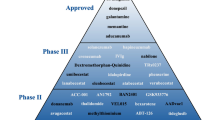Abstract
Fursultiamine (TTFD), a derivative of thiamine, at an oral dose of 100 mg/day had a mild beneficial effect in patients with Alzheimer's disease in a 12-week open trial. The improvement could be observed not only in their emotional or other mental symptoms but also in intellectual function. Only mildly impaired subjects showed cognitive improvement. Alzheimer patients' blood levels of thiamine before the trial were within the normal range. No adverse reactions were observed and all patients tolerated the trial well. TTFD could afford an alternate treatment to large doses of thiamine hydrochloride in Alzheimer patients. However, further investigations of the therapeutic implications of thiamine and its possible etiologic clues to Alzheimer's disease are necessary.
Similar content being viewed by others
References
Blass, J.P., Gleason, P., Brush, D., DiPonte, P., and Thaler H. (1988). Thiamine and Alzheimer's disease. A pilot study.Arch. Neurol. 45:833–835.
Blass, J.P., Sheu, K.F.R., Cooper, A.J.L., Jung, E.H. and Gibson, G.E. (1992). Thiamine and Alzheimer's disease.J. Nutr. Sci. Vitaminol. Tokyo. Spec No:401–404.
Butterworth, R.F., and Besnard, A.M. (1990). Thiamine-dependent enzyme changes in temporal cortex of patients with Alzheimers disease.Metab. Brain Dis. 5:179–184.
Cooper, J.R., and Pincus, J.H. (1979). The role of thiamine in nervous tissue.Neurochem. Res. 4:223–239.
Erder, L., Hirt, L., and Dunant, Y. (1976). Possible involvement of thiamine in acetylcholine release.Nature 264:186–188.
Folstein, M.F., Folstein, S.E., and McHugh, P.R. (1975). A practical method for grading the cognitive state for the clinician.J. Psychiatr. Res. 12:189–198.
Gibson, G., Barclay, L. and Blass, J.P. (1982). The role of the cholinergic system in thiamine deficiency.Ann. N.Y. Acad. Sci. 378:382–403.
Gibson, G.E., Sheu, K.F.R., Blass, J.P., Baker, A., Carlson, K.C., Harding, B., and Perrino, P. (1988). Reduced activities of thiamine-dependent enzymes in the brains and peripheral tissues of patients with Alzheimer's disease.Arch. Neurol. 45:836–840.
Goodwin, J.S., Goodwin, J.M., and Garry, P.J. (1983). Association between nutritional status and cognitive functioning in a healthy elderly population.J.A.M.A. 249:2917–2921.
Gottfries, C.G., Brane, G, Gullberg, B., and Steen, G. (1982). A new rating scale for dementia syndrome.Arch. Gerontrol. Geriatr. 1:311–330.
Hasegawa, K. (1983). The clinical assessment of dementia in the aged. A dementia screening scale for neuropsychiatric patients. In: M. Bergener, U. Lehr, E. Lang and R. Schmitz-Scherzer (eds.).Aging in the Eighties and Beyond, Springler, New York, pp 207–218.
Iida, S. (1966). Rapid formation of thiamine triphosphate in heart muscle after administration of disulfide derivatives of thiamine.Behav. Pharmacol. 15:1139–1145.
Mastrogiacomo, F., Bergeron, C., and Kish, S.J. (1993). Brain α-ketoglutarate dehydrogenase complex activity in Alzheimer's disease.J. Neurochem. 61:2007–2014.
Meador, K., Loring, D., Nichols, M., Zamrini, E., Rivner, M., Posas, H., Thompson, E., and Moore, E. (1993). Preliminary findings of high-dose thiamine in dementia of Alzheimer's type.J. Geriatr. Psychiatry Neurol. 6:222–229.
Nolan, K.A., Black, R.S., Sheu, K.F.R., Langberg, J., and Blass, J.P. (1991). A trial of thiamine in Alzheimer's disease.Arch. Neurol 48:81–83.
Rao, V.L.R., Richardson, J.S. and Butterworth, R.F. (1993). Decreased activities of thiamine diphosphatase in frontal and temporal cortex in Alzheimers disease.Brain Res. 631:334–336.
Suzuoki, J., and Suzuoki, T. (1953). The concentrative uptake of thiamine alkyl disulfides by rabbit or chick blood cells.J. Biochem 40:11–20.
Yamashita, H., Zhang, Y.X., and Nakamura, S. (1993). The effects of thiamin and its phosphate esters on dopamine release in rat striatum.Neurosci. Lett. 158:229–231.
Author information
Authors and Affiliations
Rights and permissions
About this article
Cite this article
Mimori, Y., Katsuoka, H. & Nakamura, S. Thiamine therapy in Alzheimer's disease. Metab Brain Dis 11, 89–94 (1996). https://doi.org/10.1007/BF02080934
Published:
Issue Date:
DOI: https://doi.org/10.1007/BF02080934




